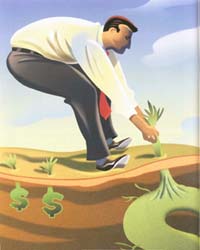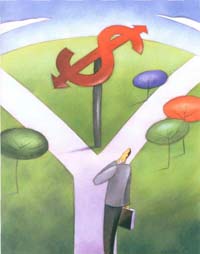|

|
3 billion ways
Three Billion Ways Park and Rec Agencies Boost the State's Economy
Study explores The Economic Impact of Local Park and Recreation Agencies in Illinois
It's easy to remind state and local policymakers that park and recreation agencies improve the quality of life for people in Illinois. But, while the state's park and recreation industry conserves green space and helps trim Illinoisan's waistlines, it also bulks up the state's economy.
By Chris Brewer and Lynn McClure
|
www.ipparks.org March/April 2005 14-15
|
Parks and recreation are a big industry in this state. Just how big is the subject of a recent report published by the Illinois Association of Park Districts. The study, The Economic Impact of Local Park and recreation Agencies in Illinois, found that park districts, forest preserve and conservation districts and municipal park and recreation agencies constitute a $3 billion dollar industry and directly support nearly 63,000 jobs statewide.
The impetus for the study came from the IAPD Research Advisory Council, whose mission is to encourage and collect research that will advance parks and recreation in Illinois. The council recommended that IAPD engage the services of the Chicago office of Economics Research Associates (ERA), an international firm that has been serving the entertainment, leisure, real estate and tourism industries for close to fifty years providing economic, feasibility, and public policy analyses.
The work began with the annual IAPD membership survey, sent to 331 member agencies around the state. That instrument covered more than 20 economic-related questions.
"The IAPD membership survey was a valuable and vital starting point for data collection," said Dan Martin, Vice President ERA. "Then we filled gaps with a detailed second survey and hundreds of phone calls and e-mails to complete the picture."
A follow-up survey administered by ERA was sent to about 165 agencies. The sample included a number of agencies that are currently not members of IAPD. To boost participation, ERA made follow-up calls to every surveyed park agency; calls were also made to check reported survey results and inconsistencies. In all, ERA tallied 383 responses.
To increase the value of the findings, ERA analyzed the data across two defined regions: Metro Chicago, covering a seven-county market, which included 203 park agencies; and Downstate, covering a 95-county area, which
included 146 park agencies.
Researchers analyzed the following key impacts in three major categories:
1. Direct employment and earnings
2. Other operational spending
3. Capital spending for construction
projects
The third category creates additional jobs and wages. All of these expenditures into the Illinois economy ripple through for a time, creating a multiplier effect that supports more jobs and wages. Illinois parks and recreation turns out to be a major employer in the state that directly injects more than a billion dollars into the economy through salaries, wages and operations each year.
Direct Employment and Earnings
In the first key impact category, Illinois park districts, forest preserves, conservation districts and municipal park and recreation agencies employ 62,900
persons each year, including approximately 8,700 full-time jobs. ERA estimates these full-time jobs support over $330 million in earnings and almost $70 million in benefits each year. The average full-time wage per employee is slightly more than $38,000, and benefits are estimated to equal about $10,000 in benefits per employee.
The 54,200 part-time employees include seasonal positions. They generate almost $222 million in additional earnings.
"Employed between May and August each year, many of these seasonal employees are high school and college-aged persons," said Ted Flickinger, Chief Executive Officer of the IAPD. "This points to park and recreation agencies being one of Illinois' major employers of young people — a critical sector."
The average wage per part-time and seasonal employee is a little over $4,000. ERA'S approach converts the part-time/seasonal positions into full-time equivalent (FTE) positions, using average wage benchmarks, between $35,700 and $38,600. From this basis, the 54,000 part time positions equate to more than 5,800
|

|
If current capital reinvestment levels are sustained over the next 10 years, a total of about $3.4 billion will be reinvested in parks, forest preserves and conservation areas around the state.
|

|
16-17 Illinois Parks and Recreation www.ILipra.org

Capital construction projects, like this one to create a walking path through Oak Lawn's Wolf Wildlife Refuge, put $371 million into the Illinois economy.
|
FTE positions (in addition to the 8,700 full time positions.)
Direct Spending
In a second key impact category, public park agencies inject another $476 million in operational spending into the economy each year for such services and products as wholesale and retail supplies; phone services; utilities; legal, auditing, architectural and planning services; and consulting and contractual services.
Based on the survey responses, ERA determined that about 73 percent of total operational spending is captured by instate businesses. Table 1 shows that Illinois' park, conservation and recreation agencies generate a combined total of more than $475 million in operational spending, of which $347 million is paid to in-state suppliers.
Capital Spending for Construction Projects
In the third key category, Illinois park agencies generated a total of $371 million in capital investment for construction of new park facilities and natural areas development, of which about $337 million was captured by in-state businesses.
"If current capital reinvestment levels are sustained over the next 10 years, a total of about $3.4 billion will be reinvested in local parks, forest preserves and conservation areas around the state. That is a considerable amount of reinvestment in quality of life," says Martin.
Fiscal benefits within the state include state and local government taxes paid, fees and intergovernmental agreements. For this analysis, ERA estimates income tax revenues in Illinois for direct full- and part-time/seasonal jobs are almost $17 million annually.
The study also looked at agency budget structure and the breakdown of financial support for park districts. Only about 50 percent of annual operating budget support is derived from property taxes. The remainder of operating budgets comes from facility and program fees, grants and donations.
Multiplier Impacts
Two of the three key direct impact categories — operations and capital expenditures - support additional jobs and wages across the state. These are known as indirect, ripple or multiplier economic impacts. While somewhat more difficult to quantify than the direct jobs, wages and purchases, these indirect impacts are just as real and just as important. Park agency employees spend their income across Illinois for homes, food, cars, merchandise and entertainment. And the local businesses and employees that provide ongoing services and material to park programs do the same.
This increased economic activity generates a range of new jobs and wages throughout the area. Thus the wages that park programs generate are spent and re-spent in the local economy and gradually evolve out of the region to outside suppliers, taxing entities, etc.
|
Table 1. Estimated Operating Expenses by Line Item
|
|
Line Item
|
Metro Aggregate
|
Downstate Aggregate
|
Total
|
|
Professional
|
$34,360,000
|
$8,220,000
|
$42,580,000
|
|
Contractual Services
|
$84,080,000
|
$6,270,000
|
$90,350,000
|
|
Wholesale Supplies
|
$76,938,000
|
$15,636,000
|
$92,574,000
|
|
Retail Supplies
|
$51,292,000
|
$10,424,000
|
$61,716,000
|
|
Telecommunications
|
$9,950,000
|
$1,850,000
|
$11,800,000
|
|
Utilities
|
$48,720,000
|
$8,060,000
|
$56,780,000
|
|
Other
|
$104,900,000
|
$14,860,000
|
$119,760,000
|
|
Total Op. Exp.
|
$410,240,000
|
$65,320,000
|
$475,560,000
|
|
Note: Other expenditures includes items that did not precisely fit into ERA'S categories Source: Economics Research Associates
|
18 Illinois Parks and Recreation www.ILipra.org
|
Table 2. Multiplier Earnings
|
|
Category
|
Direct Wages
|
Indirect Wages
|
Total Impact
|
|
Metro Aggregate
|
$466,620,000
|
$670,160,000
|
$1,136,780,000
|
|
Downstate Aggregate
|
$86,590,000
|
$124,360,000
|
$210,950,000
|
|
Total
|
$553,210,000
|
$794,520,000
|
$1,347,730,000
|
|
Source: Economics Research Associates
|
Table 2 summarizes total direct and indirect earnings for all park agencies, highlighting a cumulative impact of about $1.3 billion in total wages supported across the state, of which almost $800 million is attributed to indirect wages, supported by park agency employees.
ERA research indicates that Illinois park agencies support a combined total of more than $475 million in direct operating expenses. Using a multiplier approach, these operational expenses support over 9,700 indirect FTE jobs and $316 million in earnings across the state.
Annual capital expenditure breakdowns for labor and materials indicate that almost 10,000 total jobs are derived from park agency construction investments, with almost 6,000 short-term positions supported across the state by direct construction employment.
ERA performed similar estimates for direct and indirect earnings attributed to construction (Table 3). Almost $400 million in total earnings annually can be attributed to capital spending, of which more than $185 million is directly attributable to
construction projects at Illinois park and recreation agencies.
The Bottom Line
The study concludes that 60,340 full-time equivalent direct and indirect jobs are supported by park districts, forest preserve and conservation districts and municipal park and recreation agencies in Illinois. As a whole, these agencies contributed $3 billion in cumulative spending, earnings and other related economic activity, to the statewide economy.
"We have always known that we were 'big business,'" said Jerry Handlon, the retired director of the Schaumburg Park District who chaired the Research Advisory Council in 2004. "And this study proves it: parks and recreation is vital, not only to improving our quality of life, but also to the state's economic engine."
|
Table 3. Annual Multiplier Earnings Impact From In-State Construction Investment
|
|
Category
|
Direct Earnings
|
Indirect Earnings
|
Total Earnings
|
|
Metro Aggregate
|
$152,470,000
|
$174,940,000
|
$327,410,000
|
|
Downstate Aggregate
|
$32,810,000
|
$37,650,000
|
$70,460,000
|
|
Total
|
$185,280,000
|
$212,590,000
|
$397,870,000
|
|
Source: Economics Research Associates
|
Chris Brewer is a research analyst and project coordinator for Economics
Research Associates' Chicago office. He has prepared market and financial feasibility studies, as well as
needs analyses for park master plans, golf courses and recreational facilities throughout the U.S.
Lynn McClure is president of McClure Communications and a public relations strategist for the Illinois Association of Park Districts. She consults with park districts, forest preserve and conservation districts and environmental organizations throughout the state.
|
ON THE WEB
The complete report, The Economic Impact of Local Park and Recreation Agencies in Illinois, is available to download from the IAPD web site at:
www.Ilparks.org.
A concise version of the study will be presented and distributed at the IAPD Legislative Conference on May 4.
|
www.ilparks.org March/April 2005 19
|

